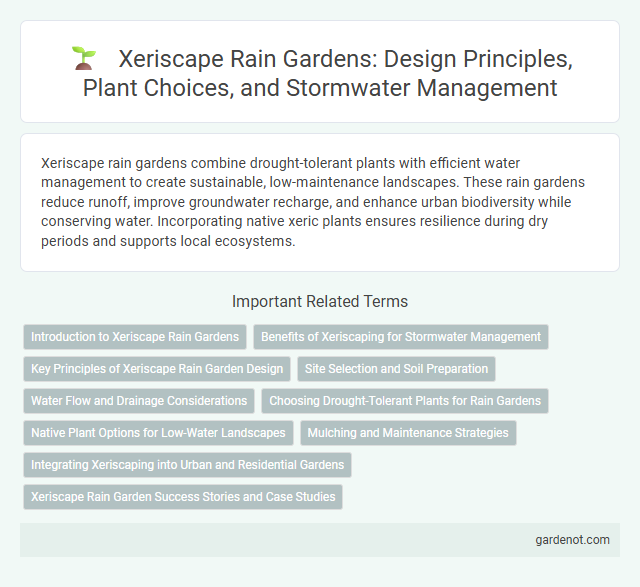Xeriscape rain gardens combine drought-tolerant plants with efficient water management to create sustainable, low-maintenance landscapes. These rain gardens reduce runoff, improve groundwater recharge, and enhance urban biodiversity while conserving water. Incorporating native xeric plants ensures resilience during dry periods and supports local ecosystems.
Introduction to Xeriscape Rain Gardens
Xeriscape rain gardens integrate drought-tolerant plants and efficient water management to create sustainable landscapes that reduce irrigation needs and manage stormwater runoff effectively. These gardens utilize native, resilient species adapted to local climates, enhancing soil infiltration while minimizing water waste. By combining xeriscaping principles with rain garden design, they promote ecological balance and conserve water resources in urban and suburban environments.
Benefits of Xeriscaping for Stormwater Management
Xeriscape rain gardens use drought-tolerant plants and efficient landscaping techniques to reduce water runoff and enhance stormwater infiltration. These gardens minimize soil erosion and filter pollutants, improving overall water quality in urban environments. Incorporating xeriscaping in stormwater management lowers water consumption and promotes sustainable, eco-friendly rainwater absorption.
Key Principles of Xeriscape Rain Garden Design
Xeriscape rain garden design emphasizes water conservation through the use of drought-tolerant native plants that thrive in local climates, reducing irrigation needs and promoting biodiversity. Efficient soil management involves amending soil to improve permeability and moisture retention, which enhances stormwater infiltration and prevents runoff. Strategic placement and layering ensure optimal water absorption and filtration, aligning with sustainable landscaping practices that minimize environmental impact.
Site Selection and Soil Preparation
Xeriscape rain garden site selection requires evaluating natural drainage patterns, sunlight exposure, and proximity to downspouts or impermeable surfaces to optimize water capture and plant health. Soil preparation involves amending heavy clay or sandy soils with organic matter to enhance infiltration and nutrient retention while achieving a balanced texture for drought-tolerant native plants. Proper grading and incorporation of mulch layers improve moisture conservation and reduce erosion in xeriscape rain garden environments.
Water Flow and Drainage Considerations
Xeriscape rain gardens are designed to optimize water flow by incorporating native, drought-tolerant plants that enhance infiltration and reduce runoff. Effective drainage considerations include grading the garden to direct excess water toward infiltration zones, preventing soil erosion and water pooling. Incorporating porous soils and strategically placed mulch layers further improves water absorption and maintains a balanced hydration cycle.
Choosing Drought-Tolerant Plants for Rain Gardens
Selecting drought-tolerant plants such as lavender, sedum, and ornamental grasses enhances the effectiveness of xeriscape rain gardens by reducing water consumption while promoting soil infiltration. These resilient species thrive in fluctuating moisture conditions, supporting the garden's ability to manage runoff sustainably. Incorporating native drought-resistant plants ensures biodiversity and long-term maintenance ease in rain garden ecosystems.
Native Plant Options for Low-Water Landscapes
Xeriscape rain gardens utilize native plant options such as purple coneflower, black-eyed Susan, and switchgrass, which thrive in low-water landscapes while enhancing local biodiversity. These drought-tolerant species reduce irrigation needs and improve soil filtration, promoting sustainable water management. Incorporating native plants adapted to regional climate conditions supports resilient ecosystems and minimizes maintenance requirements in xeriscape rain garden designs.
Mulching and Maintenance Strategies
Mulching in xeriscape rain gardens conserves soil moisture, reduces weed growth, and prevents erosion by using organic materials like bark or wood chips. Maintenance strategies emphasize minimal watering, regular inspection for debris buildup, and prompt removal of invasive plants to sustain water efficiency. Proper mulching combined with strategic upkeep ensures the rain garden's long-term effectiveness in stormwater management and drought resilience.
Integrating Xeriscaping into Urban and Residential Gardens
Xeriscape rain gardens optimize water conservation by using drought-tolerant native plants and efficient irrigation techniques, reducing urban runoff and enhancing groundwater recharge. Integrating xeriscaping in residential landscapes promotes sustainable water management, lowers maintenance costs, and supports local biodiversity. These gardens effectively mitigate stormwater pollution while creating aesthetically pleasing, eco-friendly urban green spaces.
Xeriscape Rain Garden Success Stories and Case Studies
Xeriscape rain gardens have demonstrated significant success in water conservation and stormwater management by utilizing drought-tolerant native plants and efficient irrigation techniques. Case studies reveal reduced runoff, improved soil infiltration, and enhanced urban biodiversity, highlighting the practical benefits of xeriscape principles in rain garden design. Communities implementing xeriscape rain gardens report lower maintenance costs and increased resilience during drought conditions, validating their effectiveness in sustainable landscaping.
Xeriscape rain garden Infographic

 gardenot.com
gardenot.com